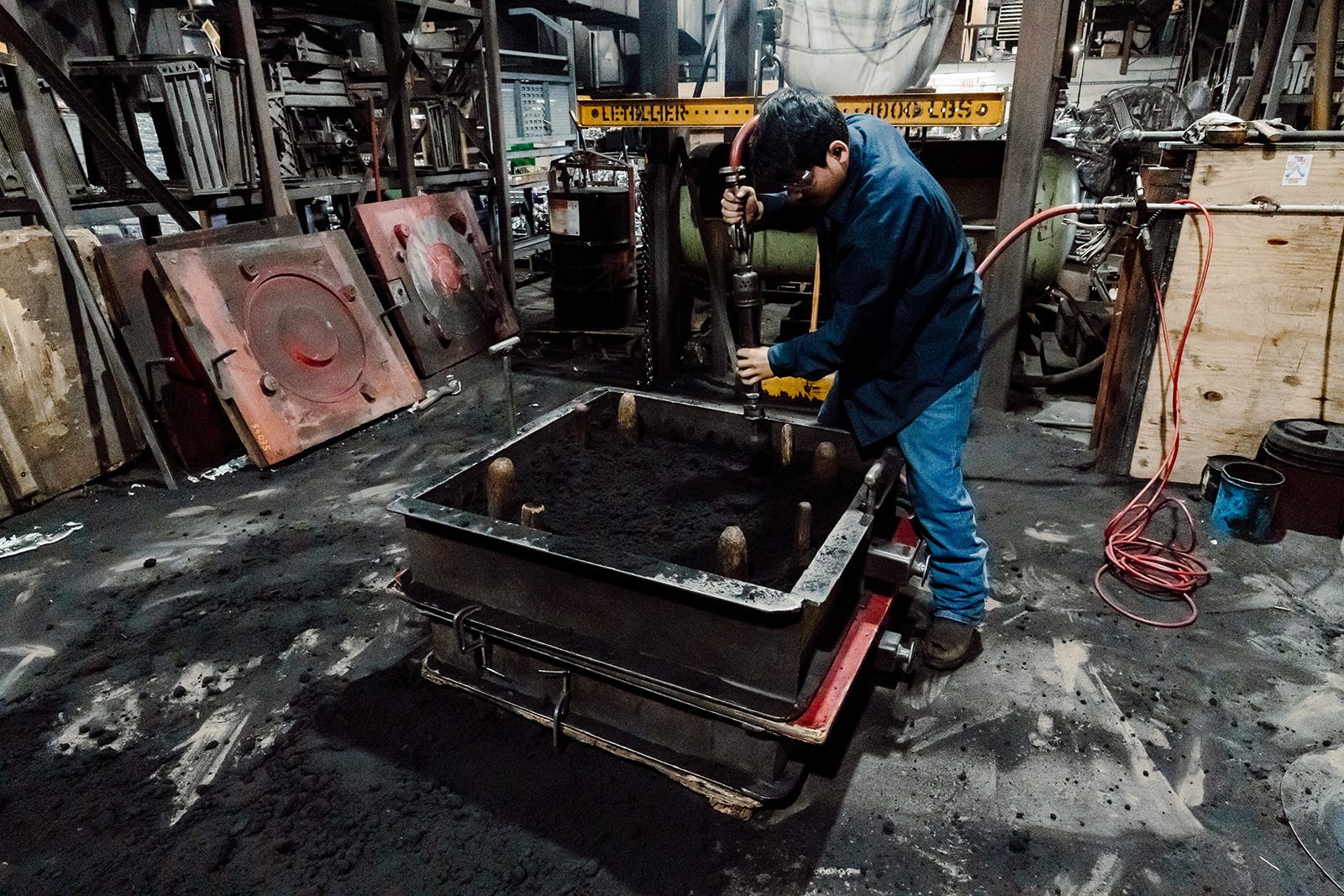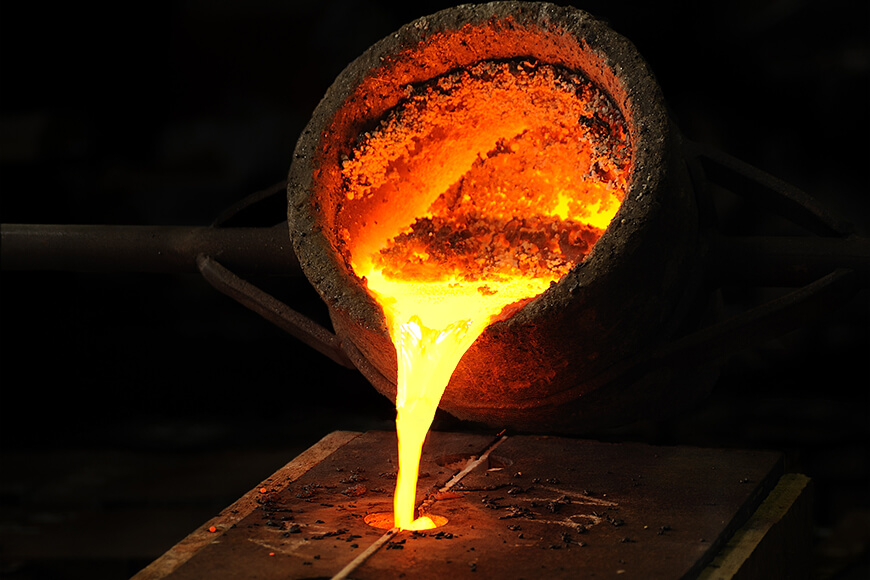The Ultimate Guide to Sustainable Practices in Casting Foundry Workflows
A Comprehensive Guide to the Solutions Used by Casting Foundry Experts
Casting Foundry professionals play an important function in the production sector. They provide a multitude of solutions that cover the entire Casting process, ensuring precision and high quality. From mold and mildew design to steel putting techniques, each facet is carefully crafted. Quality control steps guarantee that criteria are met. Nevertheless, the subtleties of these procedures often go unnoticed. Understanding the full variety of services can expose their effect on various sectors and applications.
Comprehending Casting Procedures
Although casting processes may vary considerably, they all share a typical goal: transforming raw products right into accurate, functional shapes. Casting Foundry. These procedures encompass various methods, including sand spreading, pass away spreading, and financial investment spreading, each fit to details applications and products. In sand spreading, mold and mildews are created from sand and a binding agent, enabling versatility in layout and dimension. Pass away spreading, on the other hand, uses high-pressure injection to create elaborate shapes from molten metal, ensuring high precision and repeatability. Investment Casting involves creating a wax pattern, which is covered in ceramic product, permitting for premium surface area finish and dimensional accuracy. Despite the method picked, the basic concepts of heating, pouring, and solidifying products stay constant. By comprehending these processes, manufacturers can pick one of the most proper technique for their needs, making certain performance and high quality in production
Pattern Making Techniques
Pattern production methods play a critical role in the Casting procedure, acting as the blueprint for the end product. These methods entail producing an accurate reproduction of the preferred item, which is then utilized to form mold and mildews. Different materials, such as plastic, wood, or steel, can be utilized to craft patterns, depending on the intricacy and requirements of the Casting task.
Among the usual methods are strong patterns, which are straight and simple, and split patterns, which permit more detailed styles by dividing the pattern into 2 halves. In addition, core patterns are utilized to produce internal tooth cavities within spreadings.
Improvements in technology have actually introduced digital pattern production and 3D printing, enabling quicker manufacturing and greater accuracy (Casting Foundry). These innovations boost the efficiency and accuracy of the Casting procedure, ensuring that the end products meet rigid top quality requirements while lowering lead times
Mold Style and Design
Mold and mildew design and engineering are vital parts in the Casting procedure, affecting the total high quality of the end product. The layout process includes cautious factor to consider of product selection requirements and the application of simulation and screening strategies to guarantee peak efficiency. Understanding these elements is crucial for achieving efficient and effective mold manufacturing.
Layout Refine Review
The design procedure for casting Foundry solutions is a crucial phase that encompasses mold design and engineering. This stage begins with understanding the specific requirements of the component to be produced, including measurements, resistances, and total capability. Designers use computer-aided style (CAD) software program to produce in-depth designs, making sure accuracy in the mold and mildew's geometry.
Cooperation between customers and designers is crucial, as it aids to attend to any type of prospective design obstacles beforehand. As soon as the first layout is authorized, prototypes may be developed for testing purposes. This repetitive procedure permits improvements and modifications, guaranteeing the final mold and mildew satisfies all specifications. Ultimately, effective mold and mildew design and design are essential for achieving high-quality Casting outcomes while enhancing manufacturing effectiveness.
Material Option Criteria
When identifying the ideal materials for mold and mildew style and design, it is important to review different variables that impact the efficiency and long life of the Casting process. Secret considerations include thermal conductivity, which influences heat transfer; mechanical stamina, making certain the mold endures stress; and resistance to put on and deterioration, which prolongs mold life. In addition, the compatibility of the product with the molten metal is crucial to avoid reactions that might compromise the casting. Cost-effectiveness and simplicity of machining additionally play substantial functions in product option. Ultimately, selecting the appropriate materials aligns with the particular demands of the task, making certain efficient production and premium castings. Proper examination of these requirements will certainly bring about excellent mold efficiency and resilience.
Simulation and Evaluating Strategies
Using innovative simulation and screening strategies is crucial for optimizing mold and mildew layout and design. These techniques enable casting Foundry experts to predict just how mold and mildews will certainly do under different conditions, thus decreasing product waste click here for more info and lowering preparations. Finite element analysis (FEA) and computational liquid characteristics (CFD) are typically used to examine structural integrity and liquid circulation within molds. By mimicing various circumstances, engineers can identify prospective problems prior to physical production begins. In addition, model testing enables real-world recognition of style selections, making certain that molds meet performance specifications. Integrating these techniques not only improves the accuracy of mold styles but additionally adds to the overall efficiency and cost-effectiveness of the Casting process, resulting in higher-quality end products.
Metal Pouring Approaches
Pouring liquified metal into molds is a crucial action in the Casting process, affecting the final item's quality and architectural integrity. Various steel pouring approaches are employed by casting shops to achieve suitable results. One of the most common strategies include gravity putting, where metal streams right into the mold exclusively under the influence of gravity, and pressure putting, which utilizes employed pressure to ensure full mold dental filling. In addition, vacuum putting is made use of to remove air pockets and enhance surface area finish, while centrifugal putting utilizes rotational force to disperse the metal evenly within the mold and mildew. Each approach provides unique benefits depending upon the sort of steel, mold and mildew design, and desired attributes of the last product. Foundry professionals examine these variables meticulously to select the most appropriate putting approach, guaranteeing that the Casting meets the needed specs and efficiency standards. Comprehending these strategies is essential for achieving top notch spreadings in numerous sectors.
Heat Treatment and Completing Procedures
Warmth therapy and ending up procedures play an essential role in enhancing the mechanical residential properties and surface area quality of castings. These processes include a series of controlled home heating and cooling down cycles, which modify the microstructure of the steel, leading to improved strength, ductility, and resistance to wear. Usual warmth therapy techniques include tempering, annealing, and quenching, each customized to accomplish particular material characteristics.
Following warmth therapy, finishing processes such as machining, grinding, and brightening are utilized to achieve exact dimensions and perfect surface coatings. These steps are necessary for reducing surface area roughness and improving visual appeal, making certain that the last product fulfills the needed specifications. In addition, completing processes can entail layer applications, which supply rust resistance and boost toughness. In general, the assimilation of warm treatment and completing procedures is important for providing top quality spreadings that meet sector standards and consumer expectations.
Quality Assurance and Testing
Quality assurance and screening are vital elements in the Casting Foundry procedure, guaranteeing that each item meets well established standards for performance and integrity. Factories apply rigorous screening methods throughout production to examine and recognize problems product residential properties. This consists of visual evaluations, dimensional checks, and non-destructive screening approaches such as ultrasonic or radiographic assessments.
The usage of advanced technology, including digital dimension systems, boosts accuracy in discovering prospective defects. In addition, material samples are commonly based on mechanical screening, evaluating ductility, hardness, and strength. These assessments are vital for confirming that castings can stand up to functional stress and anxieties in their intended applications.
Moreover, adherence to industry criteria, such as ASTM and ISO qualifications, plays a substantial duty in top quality guarantee. By maintaining complete documents of inspection results, shops can provide customers with self-confidence in the dependability and toughness of their cast items, eventually promoting long-term collaborations based upon count on.
Custom Casting Solutions and Applications
The importance of customized services in casting foundries can not be overstated, as industries significantly look for components that fulfill certain requirements. Personalized Casting options enable the production of complex geometries and one-of-a-kind materials, satisfying diverse fields such as vehicle, aerospace, and energy. Foundries make use of sophisticated technologies, consisting of 3D printing and computer-aided design, look at more info to develop prototypes and last products that straighten with client specs.
Applications range from detailed engine parts to specialized equipment components, highlighting the convenience of customized spreadings. By working together very closely with customers, foundries can guarantee that each Casting not only fulfills practical needs but likewise complies with industry criteria. This modification results in boosted performance, minimized waste, and boosted efficiency in production procedures. Inevitably, customized Casting options stand for a tactical advantage for organizations aiming to innovate and preserve affordable sides in their corresponding fields.

Often Asked Concerns
What Materials Can Be Used in Casting Procedures?
The materials used in casting procedures consist of metals like light weight aluminum, iron, and bronze, in addition to non-metals such as ceramics and plastics. Each product supplies special residential or commercial properties suited for numerous applications and Visit Your URL manufacturing requirements.
How much time Does a Typical Casting Job Take?
The duration of a regular Casting project differs significantly, frequently varying from a number of days to weeks. Factors affecting this timeline include layout complexity, product option, and the certain Casting techniques utilized by the foundry.
What Industries Advantage Most From Casting Providers?
The industries that profit most from casting services include aerospace, automobile, construction, and marine. Each field utilizes casting to create precise elements, enhancing effectiveness and efficiency in their respective applications, consequently driving innovation and development.
Can You Give Prototypes Before Full Manufacturing?

What Is the Common Cost Range for Casting Providers?
The normal expense range for casting solutions varies significantly, frequently influenced by variables such as product production, intricacy, and type quantity. Typically, prices can vary from a few hundred to several thousand bucks per project.
These procedures encompass numerous techniques, including sand spreading, die spreading, and investment spreading, each fit to specific applications and products. Mold layout and engineering are critical components in the Casting procedure, influencing the total high quality of the last product. When determining the proper materials for mold layout and engineering, it is necessary to examine different factors that impact the efficiency and long life of the Casting procedure. Pouring liquified steel right into mold and mildews is an essential step in the Casting procedure, influencing the last item's high quality and architectural integrity. Quality control and testing are essential components in the Casting Foundry procedure, ensuring that each product fulfills established requirements for efficiency and reliability.